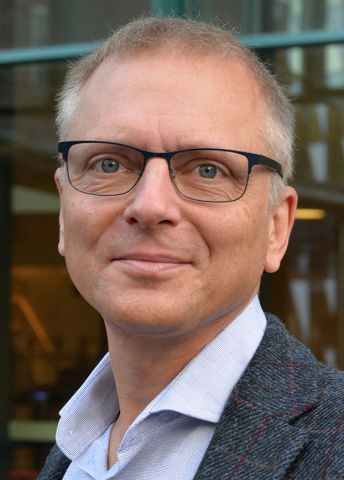
Patrik Ernfors
Professor of Tissue Biology
Wallenberg Scholar
Institution:
Karolinska Institutet
Research field:
The biology behind glioblastoma

Wallenberg Scholar
Institution:
Karolinska Institutet
Research field:
The biology behind glioblastoma
Glioblastoma is so aggressive that the average survival time for patients is only 15 months, despite treatment with the most effective available therapy including surgery, radiotherapy and chemotherapy.
“A diagnosis is a death sentence. Although research over the past few decades has given us an insight into the cellular processes leading to cancer, that knowledge has not led to any new therapies,” Ernfors says.
One of the reasons that little progress has been made is that glioblastoma is a highly heterogeneous disease. Different tumor cells carry different genetic changes, and when some of them are targeted, other cells take over – a phenomenon known as tumor evolution.
“My research requires large-scale methods, which are costly and involve time-consuming studies. This is only possible with a long-term commitment and proper funding of the kind offered under the Wallenberg Scholar scheme.”
Ernfors has therefore chosen to rewind the tape to understand the biology behind glioblastoma. For many years now, he has been studying stem cells, and has seen a link between tumor development and the development of immature stem cells.
A theory gaining wide acceptance is that growth of cancer tumors is driven by specific cancer stem cells that are also capable of creating new tumors. But the cancer stem cells are resistant to current therapies.
“We have done a lot of work on peripheral stem cells and stem cells in the central nervous system. I think it’s essential to use this knowledge to understand glioblastoma,” he says.
The goal was to map all the alterations that occur when a normal stem cell changes into a cancer cell. But first Ernfors and his research team needed to identify the normal stem cells.
Their starting point was a group of 18 patients with glioblastoma at Karolinska University Hospital. They contributed with cell samples from their tumors, which the research team then described using RNA sequencing methods which opened for a comparison with normal brain cells.
The comparison itself was possible thanks to mapping of all cell types in the brain of a mouse carried out in 2018 under the leadership of Sten Linnarsson, who is also a Wallenberg Scholar. This enabled Ernfors’ team to use machine learning methods to compare the tumor samples with the map.
“We discovered that a large proportion of the glioblastoma cells resemble the least developed cell type in the brain – radial glial cells. This confirmed the suspicion that glioblastoma originates in stem cells,” he explains.
The researchers also discovered that some glioblastoma cells instead resembled cells in the walls of the brain’s blood vessels, known as perivascular cells. This means there are several different kinds of stem cell involved in tumor growth.
The discovery of perivascular cells was confirmed with the help of yet another fellow Wallenberg Scholar: Christer Betsholtz, who has succeeded in isolating the brain’s blood-vessel cells. Once again, Ernfors could use machine learning to show a resemblance between the tumor cells and a stem cell-like cell from the blood vessel wall: the fibroblast.
“The findings are very exciting. We now believe there are two separate types of glioblastoma – one form originating in radial glial cells, and one in perivascular cells.”
The next step is to monitor the stem cells and hopefully find out what goes wrong as they develop. Ernfors is primarily focusing on perivascular cells in order to describe the molecular changes that occur both in the genome and in the transcriptome, i.e. when the genome is transcribed.
“We’re going to see many mutations along the way, many of which does not cause cancer. If we can map them in sequence and understand their role in changing the transcriptome, we will gain an insight into the biological process causing the disease.”
Ernfors is pursuing several lines of research into glioblastoma. He received widespread attention in 2014 for an article he had published in Cell, in which he revealed a potential drug molecule for treating the disease. The molecule caused the cancer cells to form so many inner membrane vesicles that they eventually ruptured. But when his own research team was unable to replicate the effect of the molecule on survival in glioblastoma models, he decided to retract the article.
“Having to retract an article is a harrowing process, even more so when it has been published in such a respected journal. Retraction naturally harms one’s reputation as a researcher, but I think you have to take responsibility if findings cannot be replicated.”
Since then the team has continued to study the molecule in order to understand its mechanisms.
“We have now succeeding in replicating an effect on survival, but the effect is not sufficient for the molecule to be of clinical interest. We are therefore continuing to study the mechanisms in order to find further ways of potentiating the effect. If we do, the molecule may be of clinical interest once more.”
Ernfors says that the impetus driving his research on glioblastoma ultimately comes from the patients. He wants to contribute to with knowledge, but most of all to help patients live longer with a better quality of life.
“But the older I get, the closer I am to retirement. So time is running short. To succeed, we have to get down to the details – there are no shortcuts.”
Text Magnus Trogen Pahlén
Translation Maxwell Arding
Photo Gunnar Ask, Andreas Andersson, Magnus Bergström